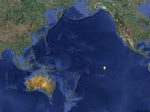For example, we have yet to see one other boat with varnished wood masts. Most masts are lightweight aluminum, or at least painted.
Also, the headsails that fly on the front of our boat are "hank-on," meaning that if we want to put more or less sail up, we have to physically remove and replace the sail with another one. Only one other boat that we saw still used that system - that was Kayak, from Seattle. All of the other boats use a roller furling system, which works kind of like a vertical paper towel rack - just pull out as much sail as you want when you want it.
To get to shore, we row our hard fiberglass dinghy, which also can be rigged with a sail. That was such an oddity, people used to line up on the wharf just watching me row by. Some cruisers felt sorry for me, and would offer to tow me back to Columbine with their motorized inflatable dinghies. Those are only easier when the motor works. But, you don't have to bring your own fenders with you when you socialize on someone else's boat! The only other cruisers we saw with hard dinghies were also from the U.S.
The list goes on, and even if you didn't clue into these somewhat more subtle differences, just the shape of Columbine would be a major tip off. She is a double-ended design ("pointy at both ends") with low sides and a narrow beam (width). She looks so old-fashioned, most people assume her hull is made of wood instead of fiberglass. Apparently, cruising this style of boat is a dead give-away that we are from the States, most likely the Pacific Northwest.
So, what do most cruisers sail now? Well, I'd say that at least half of the boats were large catamarans, offering more interior space than most apartments. These are faster than an equally-sized monohull, with a shallower draft (depth), and a more horizontal position while sailing. These boats are also close to half a million dollars brand new.
The modern cruising monohull is also wider with tall sides to maximize interior space. Most are steered with a shiny stainless steel wheel instead of the varnished wooden tiller Columbine has. The transom is flat, and often low to the water with built-in steps. We got to visit some of these boats while socializing with the other cruisers. Standing on the decks, I imagine I had the same feeling I would have if I were sitting in the cab of a semi when I was used to driving a Volkswagen Bug.
I have to say, it's been a lot of fun interacting with so many other boaters, and learning about their boats. The vast majority of my boating experience has been on Columbine, so I am always fascinated when I find out other people do it differently. Sometimes, we think others do things better, and we figure out a way to make that happen on Columbine. Other times… well, maybe we're just strange and old-fashioned - we revel in accomplishing things the "hard way." We are Americans, recently from the Pacific Northwest, and I guess it shows.
We now have just over 4,000 miles to go before we're back! Our current position is 04° 05.5'S; 148° 09.9'W, and sailing at a slow 3 knots NNE.









